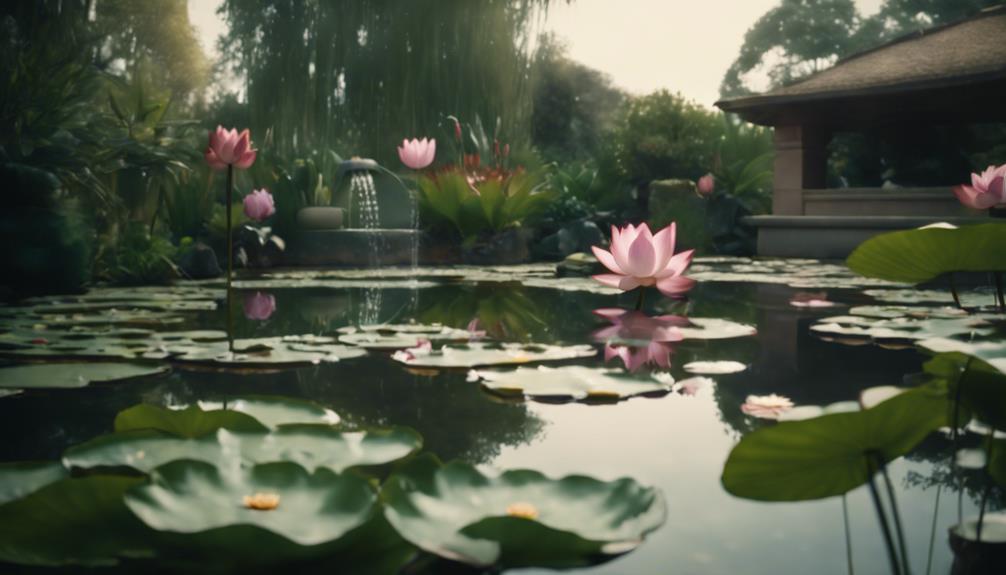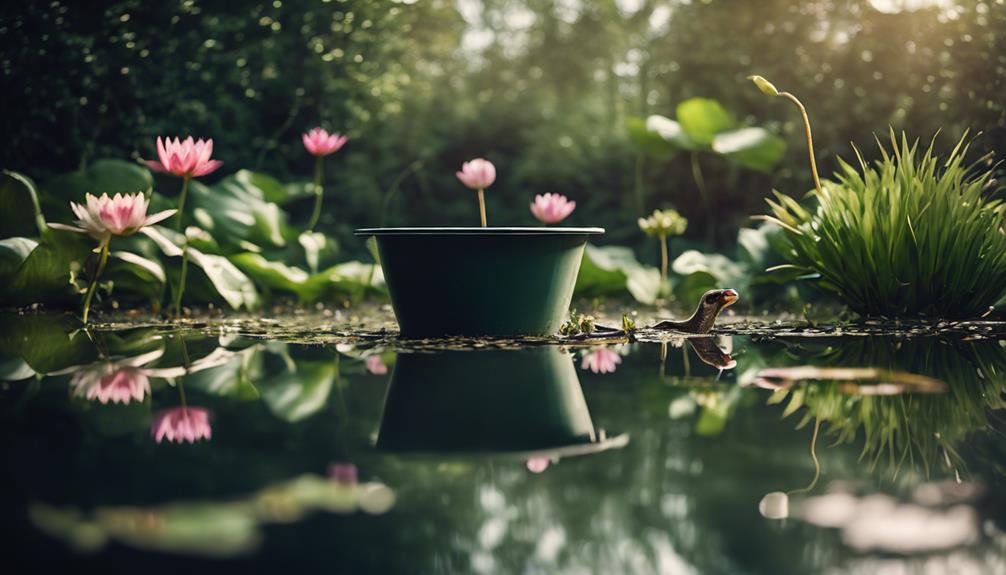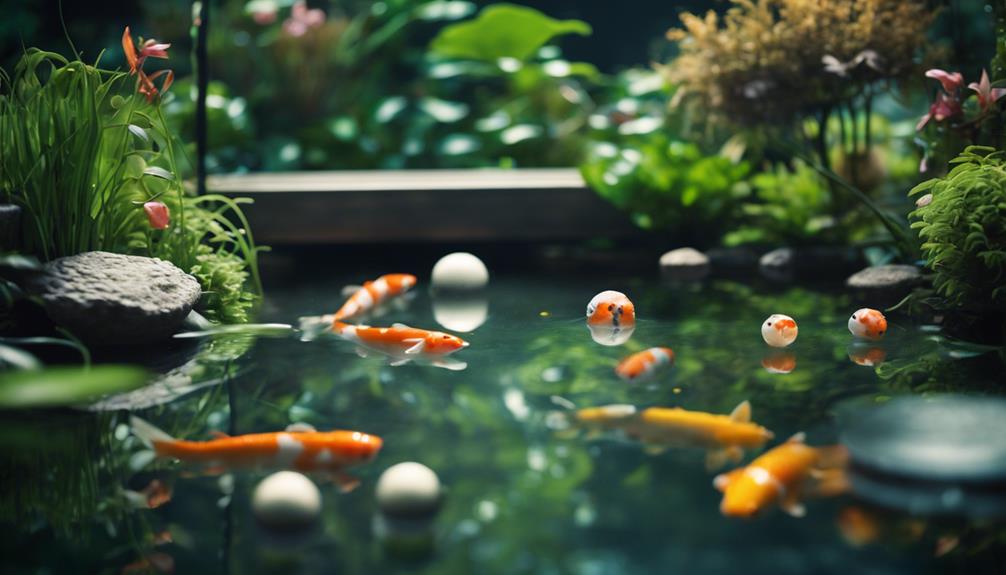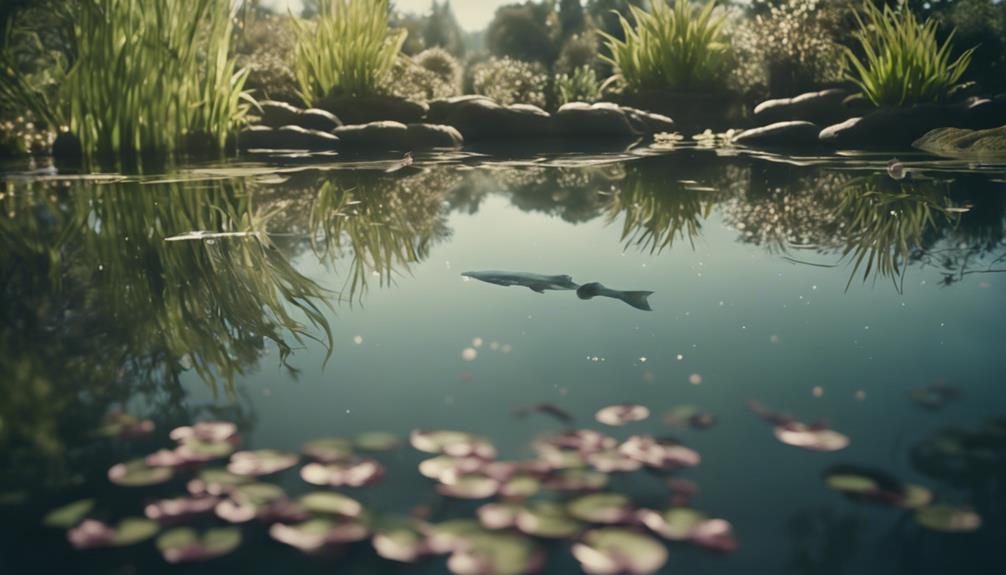You can clarify murky garden water by understanding the underlying causes of cloudy, green, brown, or gray water, which can stem from suspended soil, algae particles, high nutrients, or phosphate levels. Effective DIY filtering solutions include using polyester quilt batting with a recirculating pump or alternative setups like pond pumps and filters. Natural methods, such as oxygenating plants, beneficial bacteria, and biofilters, can also help. Proactive maintenance practices, including regular water circulation, debris removal, and eco-friendly water management strategies, are key to preventing murky water. As you explore these solutions, you'll uncover more techniques to achieve crystal-clear water.
Table of Contents
Key Takeaways
- A DIY filtering solution using a polyester quilt batting can clarify murky garden water by removing suspended particles and debris.
- Natural clarification methods like oxygenating plants, beneficial bacteria, biofilters, and Epsom salts can also effectively clear murky water.
- Regular maintenance and prevention tips, such as removing debris and sediment, providing shade, and using barley straw, can help maintain clear water.
- Eco-friendly water management strategies, including the batting method, can be simple, inexpensive, and effective in removing debris and gunk from the water.
- Implementing a pond filter assembly and regularly removing debris and sediment from the pond floor can also help clarify murky garden water.
Causes of Murky Water
When you gaze into your garden pond, you may notice the water appears cloudy, green, brown, or gray, and these varying hues are often indicative of specific underlying causes.
Cloudy water, for instance, can be composed of suspended soil, run-off waste, suspended muck, algae particles, or a haze from high nutrients.
If your pond water has turned green, it's likely due to the presence of planktonic algae, which tends to thrive as water temperatures increase in spring and summer.
Brown water, on the other hand, can stem from multiple causes, including soil from new pond construction, heavy rains, soil erosion, and construction run-off.
Gray, murky water is often a result of high phosphate levels in the water, while large amounts of suspended organic or inorganic particles can also cause murky pond water.
Understanding the underlying causes of murky water is essential to addressing the issue effectively.
DIY Filtering Solutions
A simple, yet effective DIY filtering solution can be created to clarify your murky garden water.
One innovative approach involves using a polyester quilt batting to filter the water.
To get started, follow these steps:
Select a good quality polyester quilt batting, avoiding cotton, and cut it into pieces for multiple cleaning sessions.
Set up the filter system by placing a recirculating pump inside a plastic milk crate or similar container, covering the exterior with quilt batting, and submerging it in the pond.
Ensure good circulation to oxygenate the water and keep it clear.
Monitor and replace the quilt batting as it turns green/brown, indicating it's collected gunk, and replace it with fresh batting as needed.
Natural Clarification Methods

You can now explore alternative natural methods to clarify your garden water, including harnessing the power of oxygenating plants, beneficial bacteria, and other organic solutions. These methods are not only effective but also eco-friendly and safe for your aquatic ecosystem.
| Method | How it Works | Benefits |
|---|---|---|
| Oxygenating Plants | Remove excess sludge and bacteria | Clearer water, reduced algae growth |
| Beneficial Bacteria | Eat excess algae, particles, and small organisms | Natural, non-toxic, and safe |
| Biofilter | Filter out debris and small organisms | Suitable for small ponds, easy maintenance |
| Epsom Salts | Concentration of magnesium and sulfur clears murky water | Non-toxic, pH level unaffected |
| Pond Probiotics | Naturally remove organic matter and debris | Safe, non-toxic, and effective |
Alternative Setup Options
As you explore alternative setup options for clarifying murky garden water, you'll want to examine the role of pond pumps and filters in optimizing water circulation and quality.
You may also find that DIY aeration systems can enhance oxygen levels and facilitate natural clarification methods.
Pond Pumps and Filters
Frequently, pond owners seeking to clarify murky garden water turn to alternative setup options, including in-ground skimmers and creative filter systems that utilize everyday materials.
These setups can be just as effective as traditional pond pumps and filters, and often require minimal investment.
For instance, you can create a filtering system using a small pump, two wire mesh waste baskets, and polyester quilt batting.
- Place the pump inside the baskets, aiming the water output hose to shoot water over the top and back into the pond.
- Sandwich the polyester quilt batting between the baskets to filter out debris and gunk.
- Use a recirculating pump in conjunction with the polyester quilt batting to clarify murky garden water.
- Combine these elements to create a continuous filtering process that returns clear water to your pond.
DIY Aeration Systems
To create an alternative DIY aeration system, consider incorporating in-ground skimmers with polyester quilt batting and baking cooling racks, which can effectively clarify murky garden water.
This setup serves as a reliable option for smaller ponds, especially when used in conjunction with your main filtering system.
For an added DIY aeration system, you can set up a small waterfall with the quilt batting to filter all returning water.
This additional setup provides an extra layer of filtration and aeration, further clarifying your garden water.
For smaller ponds, another DIY option involves using two wire mesh waste baskets with a small pond pump.
Sandwich the quilt batting between the baskets, including the base, and place the pump inside.
Aim the water output hose to shoot water over the top and back into the pond, creating a continuous circulation of filtered water.
These alternative setups can be used in conjunction with your main filtering system to provide additional aeration and clarification of the water.
Natural Clarification Methods
You can explore alternative natural clarification methods to further refine your garden water, including the use of barley straw, bio-balls, and other innovative approaches. These methods can help you achieve a clear murky pond without relying on harsh chemicals.
In-ground skimmers with polyester quilt batting and baking cooling racks can help filter out debris and sediment from your garden water.
Small waterfall with quilt batting can filter all returning water, providing an additional natural clarification method.
Wire mesh waste baskets with quilt batting can be used for smaller ponds, with a small pump, sandwiching the quilt batting between the baskets to filter the water.
Using barley straw to filter water on an ongoing basis can help maintain clear water naturally, especially when combined with the quilt batting method. Bio-balls can also be used to collect pond gunk, providing an additional natural clarification method.
Maintenance and Prevention Tips

By adopting a proactive approach to pond maintenance, you can effectively prevent murky water and maintain a healthy ecosystem.
To maintain clear water, incorporate natural methods into your routine. For instance, use barley straw to filter water on an ongoing basis, as it's a natural and effective way to remove excess algae from the pond.
Prevent leaves and debris from entering the pond to prevent future issues, as they can contribute to murky water and harm the pond ecosystem.
Additionally, consider using bio-balls to collect pond gunk, which are effective for maintaining clear water naturally. You can also use them in conjunction with the quilt batting method, which is a simple, inexpensive, and effective way to keep the pond clean and healthy.
Don't forget to provide shade over your pond, as it can help reduce algae growth.
Safe and Chemical-Free Solutions
One effective, safe, and chemical-free solution for clarifying murky garden water is the batting method, which utilizes polyester quilt batting to filter out debris and gunk. This method has been tested on ponds smaller than 1000 gallons, but can also work on larger ponds with the appropriate strength of recirculating pump and enough time for all the water to be filtered.
Key benefits of the batting method include:
Maintains clear and oxygenated water: Using a recirculating pump with a sponge-type filter inside, and replacing the polyester quilt batting regularly, can help maintain clear and oxygenated water for pond fish.
Combines with natural methods: The batting method can be used in conjunction with other natural methods, such as adding beneficial bacteria, oxygenating plants, and using biofilters, to create a healthy and balanced pond ecosystem.
Requires regular maintenance: Regular maintenance, including replacing the quilt batting and cleaning the pump, is necessary to confirm the continued effectiveness of this chemical-free solution for clarifying murky garden water.
Chemical-free and safe: The batting method is a safe and chemical-free solution, making it an attractive option for pond owners who prioritize the health and well-being of their aquatic ecosystem.
Pond Filter Assembly Guide

To assemble an effective pond filter, start by selecting a suitable location for the filter unit, ensuring it's easily accessible for regular maintenance and protected from direct sunlight and strong winds.
Next, connect the pump to the filter unit, making sure it's securely attached and properly aligned.
You'll also need to connect the Water Output Hose to the filter unit, ensuring a snug and watertight fit.
Now, focus on the filter media.
Add the recommended amount of biological and mechanical media to the filter unit, following the manufacturer's instructions.
Make sure the media is evenly distributed and not compacted, allowing for efficient water flow and filtration.
Common Water Quality Issues
Cloudy, green, brown, or gray murky water can plague your garden pond, and identifying the underlying cause is essential to restoring crystal-clear water.
As you investigate the issue, you'll find that murky water can stem from various sources.
Cloudy water can be composed of suspended soil, run-off waste, suspended muck, algae particles, or a haze from high nutrients. You might notice it after heavy rainfall or when your pond is newly constructed.
Green water is typically caused by planktonic algae, and often appears as water temperature increases in spring and summer. This type of algae is microscopic and can bloom rapidly.
Brown water can stem from multiple causes, including soil from new pond construction, heavy rains, soil erosion, and construction run-off.
Gray murky water is often a result of high phosphate levels in water, and can be a sign of poor water circulation or inadequate filtration.
Debris Removal Techniques

As you tackle debris removal techniques, you'll want to focus on three key areas: removing floating debris, cleaning the pond floor, and skimming the water surface.
By targeting these areas, you'll be able to effectively eliminate excess particles and matter that contribute to murky water.
Remove Floating Debris
Your garden pond's water clarity suffers substantially when floating debris, such as dead leaves, algae, or insects, accumulates on the surface. This unwanted material not only detracts from the aesthetic appeal of your pond but also creates an ideal environment for algae growth, further degrading water quality.
To remove floating debris, you can employ the following methods:
- Skimming: Use a skimmer or a long-handled net to scoop up floating debris from the surface of the pond.
- Floating debris collectors: Install a floating debris collector, which acts as a barrier, trapping debris and preventing it from spreading.
- Pond vacuums: Utilize a pond vacuum to suck up debris and other impurities from the pond surface.
- Manual removal: Regularly inspect your pond and manually remove any visible debris, such as dead leaves or insects.
Clean Pond Floor
Remove sediment and debris from the pond floor by employing techniques that target the submerged environment, where decaying matter and organic waste can further compromise water clarity. You'll want to get to the bottom of the pond to tackle this issue head-on.
| Debris Removal Techniques | Description | Effectiveness |
|---|---|---|
| Pond Vacuum | Suctions debris and sediment from the pond floor | High |
| Rake or Skimmer | Removes larger debris and decaying matter | Medium |
| Beneficial Bacteria | Breaks down organic waste and sediment | Low-Moderate |
When you test your water, you'll likely find that the clarity improves after implementing these techniques. Regularly cleaning the pond floor prevents the buildup of decaying matter, which can lead to murky water. By targeting the submerged environment, you're taking a vital step towards achieving water that is clear and healthy. With these methods, you'll be well on your way to a thriving ecosystem. Remember, a clean pond floor is essential for maintaining water clarity, so make it a priority in your pond maintenance routine.
Skim Water Surface
Every day, skim the water surface to eliminate floating debris, such as leaves, twigs, and pollen, which can sink to the pond floor and contribute to murkiness. This simple yet effective technique helps maintain clear water and prevents the buildup of decaying matter. When you skim the water surface regularly, you'll start to see the water more clearly, and it won't be as green.
Reduces algae growth: By removing excess nutrients, you'll inhibit algae growth, which can cause the water to become cloudy or green.
Prevents debris accumulation: Skimming the surface prevents debris from sinking to the pond floor, where it can decay and contribute to murkiness.
Maintains water clarity: Regular skimming helps to keep the water clear, allowing you to see the pond's ecosystem more clearly.
Improves water quality: By removing debris and excess nutrients, you'll improve the overall water quality, creating a healthier environment for your aquatic plants and animals.
Eco-Friendly Water Management
By implementing eco-friendly water management strategies, you can effectively maintain a healthy and thriving garden pond while minimizing its environmental footprint. One such strategy is the batting method, a chemical-free solution that's simple, inexpensive, and effective. This method uses polyester quilt batting to filter pond water, making it suitable for small gardens. By setting up a filter system with a plastic milk crate, a recirculating pump, and polyester quilt batting, you can remove debris and gunk from the water before it reaches the pump, preventing future issues.
Here's a breakdown of the batting method's benefits:
| Benefit | Description |
|---|---|
| Chemical-free | No harsh chemicals needed to clear the water |
| Inexpensive | Cost-effective solution for small gardens |
| Simple | Easy to set up and maintain the filter system |
| Effective | Proven to clear murky water in a short time |
| Preventative | Regularly replacing the quilt batting helps prevent future water quality issues |
Frequently Asked Questions
How Do You Clarify Murky Water?
You clarify murky water by first conducting water testing to identify the root cause, then implementing filter systems like polyester quilt batting or mechanical filters, and if necessary, applying targeted chemical treatments to achieve excellent water quality.
How to Clear Muddy Water?
You're wondering how to clear muddy water? Start by testing the water quality to identify the issue, then remove sediment through methods like filtration or aeration, and finally, introduce aquatic plants to absorb excess nutrients and purify the water.
How to Clear up a Muddy Farm Pond?
To clear up a muddy farm pond, you'll want to focus on Farm Aeration to increase oxygen levels, optimize Pond Circulation to reduce stagnation, and conduct regular Water Testing to identify and address nutrient imbalances.
Will Lime Clear up a Muddy Pond?
You're wondering if lime can clear up a muddy pond? Before adding lime, you'll need to conduct water testing to determine the ideal lime dosage; consider pond aeration to enhance its effectiveness and achieve desired clarity.
Conclusion
As you gaze into your garden pond, crystal-clear water is now within reach.
Like a veil lifting, murky waters part to reveal a thriving ecosystem.
By implementing these methods, you've transformed your pond into a haven for aquatic life.
Remember, maintenance is key to preserving this delicate balance.
Stay vigilant, and your pond will remain a shimmering oasis, teeming with life and beauty.

